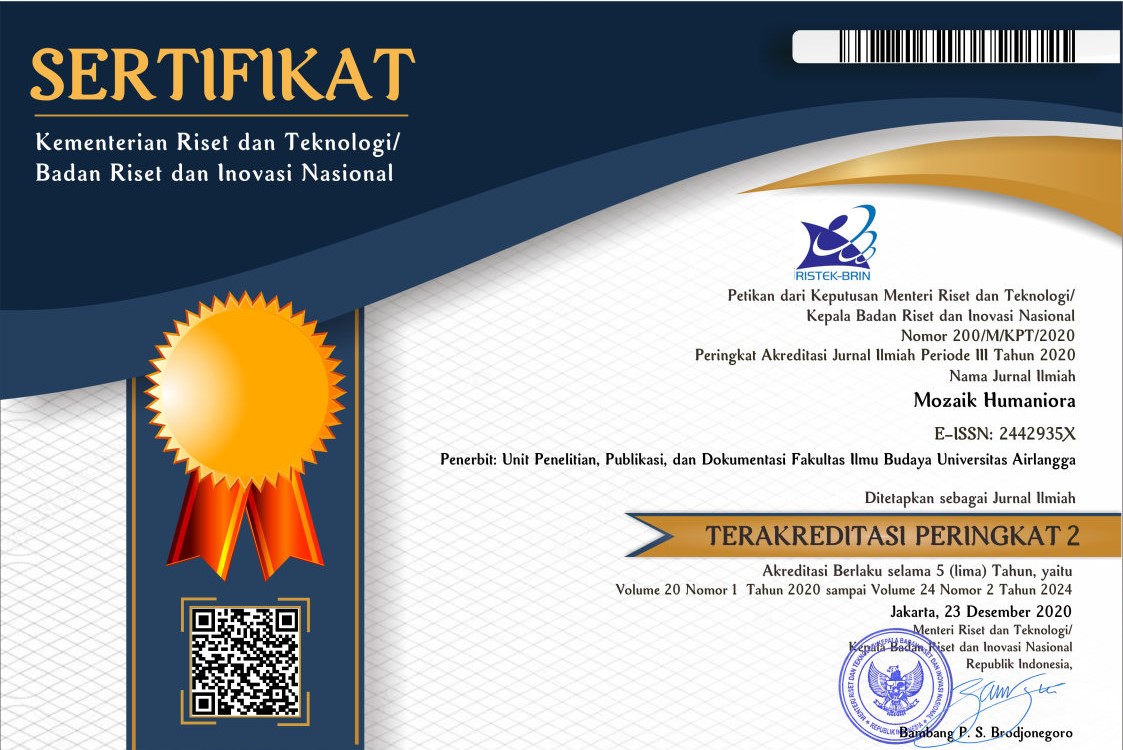Ideology through Modalities: Can the Translator Preserve Them?
Downloads
Akbarpour, Rahil. 2013. "The Impact of Pesuasive Language on Ideology Perceived in Translated Children's Literature: A Case Study.” International Journal of Comparative Literature & Translation Studies 1 (3).
Aslani, Mahdi & Bahloul Salmani. 2015. "Ideology and Translation: A Critical Discourse Analysis Approach towards the Representation of Political News in Translation.” International Journal of Applied Linguistics & English Literature 4 (3).
Assadi, Nader Aidinlou & Sholeh Mohammadpour. 2012. "An Investigation of Epistemic Modality in Literary Texts.” International Journal. Soc. Sci. & Education 2 (4).
Badran, Dany. 2002. "Ideology through Modality.” Nottingham University.
Bankole, Mercy Adenike & Moses O. Ayoola. 2014. "Mood and Modality in Christian Magazines: A Systemic Functional Analysis of Christian Women Mirror.” International Journal of Humanities and Social Science 4 (14).
Carnegie, Dale. 1981. How to Win Friends and Influence People. New York: Simon and Schuster.
Dijk, Teun. A. 2000. 18 Critical Discourse Analysis, http://www.hum.uva.nl/teun/cda.htm.
________. 2004. Ideology and Discourse: A Multidisciplinary Introduction. Universitat Oberta de Catalunya.
________. 2005. Discourse Analysis as Ideology Analysis. In Language and Pace, edited by C. Schaeffner and A. Wenden. Aldershot: Dartmouth Publishing.
________. 2006a. "Ideology and Discourse Analysis.” Journal of Political Ideologies:115-140.
________. 2006b. Politics, Ideology, and Discourse. Spanyol: Universitat Pompeu Fabra, Spanyol. pp: 728-740. Elsevier
________. 2009. Society and Discourse: How Social Contexts Influence Text and Talk. Cambridge University Press.
Djatmika. 2015. Memahami Seluk Beluk Teks. Surakarta: Media Insani Publishing.
Fairclough, Norman. 1989. Language and Power. London: Longman Group.
Fauzia, Nina 2005. Bagaimana Mencari Kawan dan Mempengaruhi Orang Lain. Jakarta: Binarupa Aksara.
Fowler, Roger. 1985. "Power.” Handbook of Discourse Analysis. Discourse Analysis in Society, edited by Teun. A. Van Dijk. London: Academic Press.
Ghazanfari, Mohammad & Abdullah Sarani. 2009. "The Manifestation of Ideology in a Literary Translation.” OrientaliaSuecana LVIII:25-29.
Hatim, Basil & Ian Mason. 1997. The Translator as Communicator. London: Routledge.
Iwamoto, Noriko. 2011. "Modality and Point of View in Media Discourse.” Human Studies, Kanagawa University.
Jorgensen, Marianne & Phillip. J. Louis. 2002. Discourse Analysis as Theory and Method. London: SAGE Publication.
Kiselyova, O., 2014. English Modality. Some Problems of Translation. Slovyansk State Pedagogical University. Даукові запиÑки БердÑнÑького державного педагогічного універÑитету. – 2014. – ВипуÑк ІІІ.
Koentoro. 2008. "Analisis Wacana Kritis (Teori Van Dijk dalam KajianTeks Media Massa).” Jurnal LEKSIKA 2 (2):45-55.
Martin, Albarran Reyes. 2015. "Ideological Features in the Translation of Alternative Medicine Texts.” CLINA 1 (1):11-28.
Mills, Sarah. 1997. Discourse. London and New York: Routledge.
Haj, Omar Husam. 2016. "Ideology, Media and Conflict in Political Discourse and Its Translation During the Arab Spring: Syria as a Case Study.” University of Leeds, United Kingdom (UK).
Molina, Lucia & Hurtado Albir. 2002. "Translation Techniques Revisited: A Dynamic and Functionalist Approach.” Meta XLVII (4):498-512.
Nababan, Mangatur Rudolf. 2003. Teori Menerjemah Bahasa Inggris. Yogyakarta Pustaka Pelajar.
________. 2012. "Pengembangan Model Penilaian Kualitas Terjemahan.” Jurnal Kajian Linguistik dan Sastra 24 (1):39-57.
Nartey, Mark & Ebo Ferguson Yankson. 2014. "A Semantic Investigation into the Use of Modal Auxiliary Verbs in the Manifesto of a Ghanaian Political Party.” International Journal of Humanities and Social Science 4 (3).
Newmark, Peter. 1988. A Textbook of Translation. Europe: Prentice Hall.
Nuyts, Jan, et al. 2005. On Deontic Modality, Directivity and Mood: A Case Study of Dutch Mogen and Moeten. Center for Grammar, Cognition and Typology. University of Anwerp.
Palmer, Frank Robert. 1986. Mood and Modality. Cambridge University Press.
Perez, Calzada Maria. 2003. Apropos of Ideology. Manchester: Jerome.
Pionery, Hepie & A. Isti'anah. 2017. "Modality Analysis in Melania Trump's and Ivanka Trump's Campaign Speeches in Republican National Convention, July 19th, 2016.” Jurnal of Language and Literature 17 (1).
Schaeffner, Christina. 1996. Discourse and Ideologies. Frankfurt Lodge: Multilingual Matters Ltd.
________. 2004. "Political Discourse Analysis from the Point of View of Translation Studies.” Journal of Language and Politics 3 (1).
Shuttleworth, Mark & Cowie Moira. 1997. Dictionary of Translation Studies. Manchester: St. Jerome.
Simpson, Paul. 1993. Language, Ideology, and Point of View. New York: Routledge.
The Financial Post Archived. 2008. "Dale Carnegie's How to Win Friends and Influence People, the Gold Standard of the Genre, Has Sold More than 15 Million Copies Since It Was First Published in 1937," 5 April.
Thompson, James Bogne. 1984. Studies in the Theory of Ideology. Los Angeles: University of California Press.
Watts, Steven. 2013. Dale Carnegie. New York: Other at the Wayback Machine.
Wiratno, Tri. 2003. Kiat Menulis Karya Ilmiah dalam Bahasa Inggris. Yogyakarta: Pustaka Pelajar.
Wodak, Ruth & Michael Meyer. 2001. Methods of Critical Discourse Analysis. London: SAGE Publication, Ltd.
Wodak, Ruth (ed.). 2003. Critical Discourse Analysis, Concept, History, Theory. California: SAGE Publication.
Zelenka, Radovan. 2013. "Modality in the Language of Legal Documents.” Tomas Bata University in Zlin

Mozaik Humaniora is licensed under a Creative Commons Attribution-ShareAlike 4.0 International License. Both authors and Mozaik Humaniora agree with the following attribution of journal:
1. Copyright of this journal is possession of Author, by the knowledge of the Editorial Board and Journal Manager, while the moral right of the publication belongs to the author.
2. The journal allows the author(s) to retain publishing rights without restrictions
3. The legal formal aspect of journal publication accessibility refers to Creative Commons Attribution Share-Alike (CC BY-SA).
4. The Creative Commons Attribution Share-Alike (CC BY-SA) license allows re-distribution and re-use of a licensed work on the conditions that the creator is appropriately credited and that any derivative work is made available under "the same, similar or a compatible license”. Other than the conditions mentioned above, the editorial board is not responsible for copyright violation.


















